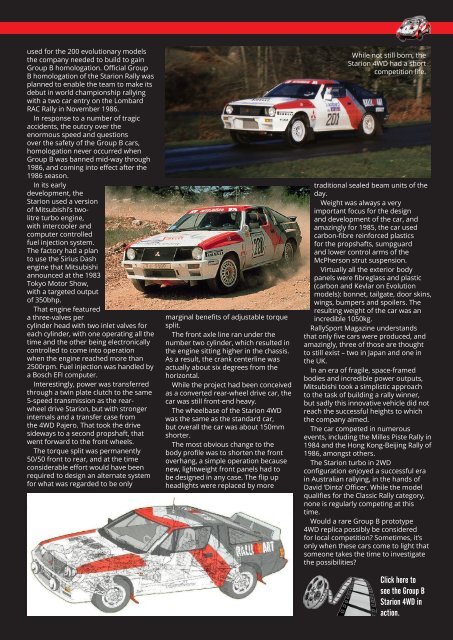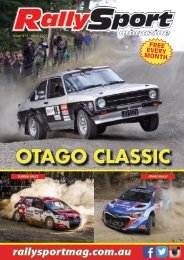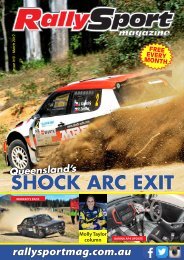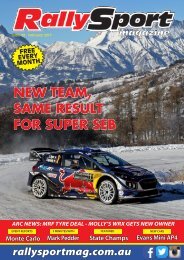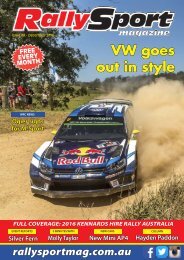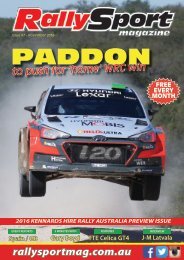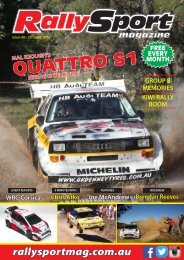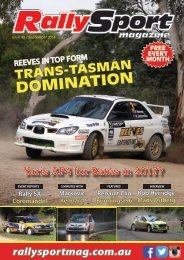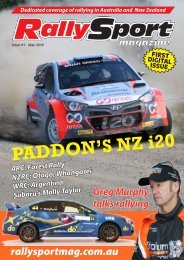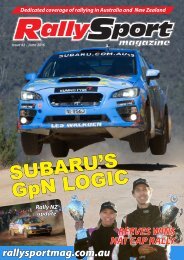RallySport Magazine August 2016
The August 2016 issue of RallySport Magazine is now available, and includes: Latest news: * Dowel backs rallycross to be bigger than V8 Supercars * Quinn’s Rally Australia WRC car bid falls short * New WRX STi could be Rally America bound * Up to 10 AP4 cars for 2017 NZRC * Skoda R5 for Mark Pedder at Rally Australia Feature stories: * Famous stages - New Zealand’s Motu * A close look at the Skoda Fabia AP4+ * Group B Mitsubishi Starion 4WD remembered * Budget rallying - Hyundai Excel * Where are they now - Wayne Bell * Hayden Paddon column * Vale: Steve Ashton Interviews: * Molly Taylor - Subaru factory driver * David Holder - NZ Rally Champion * Col Trinder - Chairman of ARCom * Emma Gilmour - NZ’s fastest lady Event reports: * Rally of Finland * APRC - China Rally * Catalans Coast Rally * NZ’s Northern Rallysprint Series * Walky 100 Rally, SARC
The August 2016 issue of RallySport Magazine is now available, and includes:
Latest news:
* Dowel backs rallycross to be bigger than V8 Supercars
* Quinn’s Rally Australia WRC car bid falls short
* New WRX STi could be Rally America bound
* Up to 10 AP4 cars for 2017 NZRC
* Skoda R5 for Mark Pedder at Rally Australia
Feature stories:
* Famous stages - New Zealand’s Motu
* A close look at the Skoda Fabia AP4+
* Group B Mitsubishi Starion 4WD remembered
* Budget rallying - Hyundai Excel
* Where are they now - Wayne Bell
* Hayden Paddon column
* Vale: Steve Ashton
Interviews:
* Molly Taylor - Subaru factory driver
* David Holder - NZ Rally Champion
* Col Trinder - Chairman of ARCom
* Emma Gilmour - NZ’s fastest lady
Event reports:
* Rally of Finland
* APRC - China Rally
* Catalans Coast Rally
* NZ’s Northern Rallysprint Series
* Walky 100 Rally, SARC
Create successful ePaper yourself
Turn your PDF publications into a flip-book with our unique Google optimized e-Paper software.
used for the 200 evolutionary models<br />
the company needed to build to gain<br />
Group B homologation. Official Group<br />
B homologation of the Starion Rally was<br />
planned to enable the team to make its<br />
debut in world championship rallying<br />
with a two car entry on the Lombard<br />
RAC Rally in November 1986.<br />
In response to a number of tragic<br />
accidents, the outcry over the<br />
enormous speed and questions<br />
over the safety of the Group B cars,<br />
homologation never occurred when<br />
Group B was banned mid-way through<br />
1986, and coming into effect after the<br />
1986 season.<br />
In its early<br />
development, the<br />
Starion used a version<br />
of Mitsubishi’s twolitre<br />
turbo engine,<br />
with intercooler and<br />
computer controlled<br />
fuel injection system.<br />
The factory had a plan<br />
to use the Sirius Dash<br />
engine that Mitsubishi<br />
announced at the 1983<br />
Tokyo Motor Show,<br />
with a targeted output<br />
of 350bhp.<br />
That engine featured<br />
a three-valves per<br />
cylinder head with two inlet valves for<br />
each cylinder, with one operating all the<br />
time and the other being electronically<br />
controlled to come into operation<br />
when the engine reached more than<br />
2500rpm. Fuel injection was handled by<br />
a Bosch EFI computer.<br />
Interestingly, power was transferred<br />
through a twin plate clutch to the same<br />
5-speed transmission as the rearwheel<br />
drive Starion, but with stronger<br />
internals and a transfer case from<br />
the 4WD Pajero. That took the drive<br />
sideways to a second propshaft, that<br />
went forward to the front wheels.<br />
The torque split was permanently<br />
50/50 front to rear, and at the time<br />
considerable effort would have been<br />
required to design an alternate system<br />
for what was regarded to be only<br />
marginal benefits of adjustable torque<br />
split.<br />
The front axle line ran under the<br />
number two cylinder, which resulted in<br />
the engine sitting higher in the chassis.<br />
As a result, the crank centerline was<br />
actually about six degrees from the<br />
horizontal.<br />
While the project had been conceived<br />
as a converted rear-wheel drive car, the<br />
car was still front-end heavy.<br />
The wheelbase of the Starion 4WD<br />
was the same as the standard car,<br />
but overall the car was about 150mm<br />
shorter.<br />
The most obvious change to the<br />
body profile was to shorten the front<br />
overhang, a simple operation because<br />
new, lightweight front panels had to<br />
be designed in any case. The flip up<br />
headlights were replaced by more<br />
While not still born, the<br />
Starion 4WD had a short<br />
competition life.<br />
traditional sealed beam units of the<br />
day.<br />
Weight was always a very<br />
important focus for the design<br />
and development of the car, and<br />
amazingly for 1985, the car used<br />
carbon-fibre reinforced plastics<br />
for the propshafts, sumpguard<br />
and lower control arms of the<br />
McPherson strut suspension.<br />
Virtually all the exterior body<br />
panels were fibreglass and plastic<br />
(carbon and Kevlar on Evolution<br />
models): bonnet, tailgate, door skins,<br />
wings, bumpers and spoilers. The<br />
resulting weight of the car was an<br />
incredible 1050kg.<br />
<strong>RallySport</strong> <strong>Magazine</strong> understands<br />
that only five cars were produced, and<br />
amazingly, three of those are thought<br />
to still exist – two in Japan and one in<br />
the UK.<br />
In an era of fragile, space-framed<br />
bodies and incredible power outputs,<br />
Mitsubishi took a simplistic approach<br />
to the task of building a rally winner,<br />
but sadly this innovative vehicle did not<br />
reach the successful heights to which<br />
the company aimed.<br />
The car competed in numerous<br />
events, including the Milles Piste Rally in<br />
1984 and the Hong Kong-Beijing Rally of<br />
1986, amongst others.<br />
The Starion turbo in 2WD<br />
configuration enjoyed a successful era<br />
in Australian rallying, in the hands of<br />
David ‘Dinta’ Officer. While the model<br />
qualifies for the Classic Rally category,<br />
none is regularly competing at this<br />
time.<br />
Would a rare Group B prototype<br />
4WD replica possibly be considered<br />
for local competition? Sometimes, it’s<br />
only when these cars come to light that<br />
someone takes the time to investigate<br />
the possibilities?<br />
Click here to<br />
see the Group B<br />
Starion 4WD in<br />
action.<br />
AUGUST <strong>2016</strong> - RALLYSPORT MAGAZINE | 61


